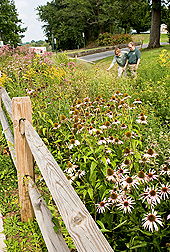This page has been archived and is being provided for reference purposes only. The page is no longer being updated, and therefore, links on the page may be invalid.
| Read the magazine story to find out more. |
|
|
Rain Gardens Sprouting Up Everywhere
By Don ComisDecember 1, 2010
Rain gardens are increasingly popular with homeowners and municipalities and are mandatory for many communities nationally. U.S. Department of Agriculture (USDA) scientists are finding ways to improve rain gardens so they not only reduce runoff, but also keep toxic metals out of storm drains.
Rain gardens are plantings in depressions that catch stormwater runoff from sidewalks, parking lots, roads and roofs. Rain gardens come in various shapes and sizes, from large basins carved by front-end loaders to small artificial streambed-like formations complete with pebbles. Rain gardens not only slow water down to give it time to soak into the ground and be used by plants, but also filter out sediment and chemical pollutants.
Plant physiologist Rich Zobel at the Agricultural Research Service (ARS) Appalachian Farming Systems Research Center (AFSRC) at Beaver, W.Va., and research associate Amir Hass, who works for West Virginia State University in Institute, W.Va., and is stationed at Beaver, are working on improving rain gardens. They are collaborating with ARS hydrologist Doug Boyer and ARS soil chemist Javier Gonzalez at Beaver, and colleagues at the ARS Southern Regional Research Center (SRRC) in New Orleans, La., and the ARS Eastern Regional Research Center (ERRC) in Wyndmoor, Pa.
ARS is USDA's principal intramural scientific research agency, and this research supports USDA's commitment to agricultural sustainability.
The scientists at the SRRC found that poultry litter biochar-activated carbons created from the charred remains of poultry litter-is a powerful pollutant magnet. It can attract heavy metals such as copper, cadmium and zinc, which are ordinarily tough to snag from wastewater.
ARS chemists Isabel Lima and Wayne Marshall (now retired) at the SRRC developed the ARS-patented method for turning agricultural bio-waste into biochar. They created the biochar by subjecting poultry litter—bedding materials such as sawdust, wood shavings and peanut shells, as well as droppings and feathers—to pyrolysis, a high-temperature process that takes place in the absence of oxygen.
Hass and colleagues are testing the poultry litter biochar as well as other farm and industrial byproducts at two demonstration rain gardens in the Beaver area, as well as at plots at a county landfill and a mineland reclamation site.
Read more about this research in the November/December 2010 issue of Agricultural Research magazine.

